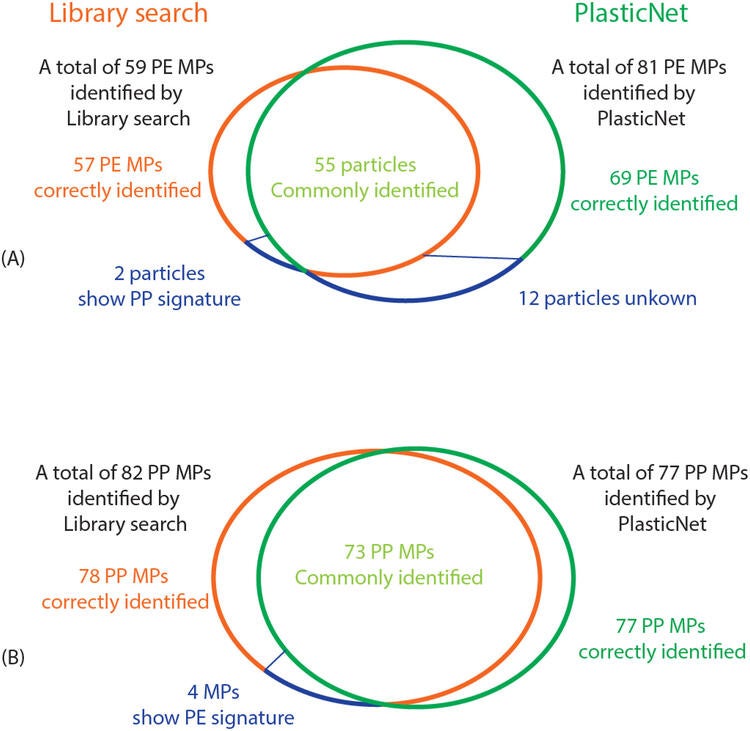Contact

Wayne Parker
Civil and Environmental Engineering

Alexander Wong
Systems Design Engineering

Ziang Zhu
Systems Design Engineering
Introduction
 Microplastics (MPs) are ubiquitous in the aquatic environment and pose threats to ecosystem and human health. Fast and accurate identification of MPs is important to understand their source, fate and transport in ecosystems. Spectral classification using conventional library search routines is a common analytical approach, but is prone to error as reference spectra are often collected from virgin plastics, while the spectra of environmentally sourced MPs can be more complex.
Microplastics (MPs) are ubiquitous in the aquatic environment and pose threats to ecosystem and human health. Fast and accurate identification of MPs is important to understand their source, fate and transport in ecosystems. Spectral classification using conventional library search routines is a common analytical approach, but is prone to error as reference spectra are often collected from virgin plastics, while the spectra of environmentally sourced MPs can be more complex.
There is growing interest in using machine learning models for automatic MP recognition. This study developed and tested PlasticNet, a deep learning convolutional neural network architecture, for spectra classification and automatic MP identification against datasets acquired by infrared spectroscopy imaging. Importantly, the study focused on the performance of PlasticNet for the recognition of MPs that had a range of thickness, additives and surface modifications.
Methodology
The PlasticNet architecture was constructed to explore the feasibility of leveraging deep learning for automatic MP recognition via Focal Plane Array (FPA)-based micro Fourier Transform Infrared (FT-IR) spectroscopy. A number of unique spectral datasets, including spectra of virgin plastic particles and spheres, plastics with surface modifications, dyes and additives, plastics of varying thickness and plastics from real wastewater treatment plant samples were acquired for the purposes of model development. The spectra were pre-processed and converted to 2-D images before identification and classification.
Spectra from several virgin plastics were used to initially train, validate, and test the model. Training of PlasticNet concluded when the total accuracy of the validation exceeded 97.5%. The model was then retrained by adding spectra from “non virgin” plastic datasets. Through a series of experiments, the performance and generalizability of PlasticNet was examined providing insights into its effectiveness in classifying complex spectra with varying levels of complexity and thickness variations. Finally, results achieved by applying PlasticNet to real environmental samples were compared to a library search method to evaluate if the model could identify MPs that were missed by a search.
Outcomes
Once trained with over 8,000 spectra of virgin plastic, PlasticNet successfully classified 11 types of common plastic with accuracy higher than 95%. A confusion matrix was used to visualize the performance of the classification with errors in identification found to be caused by edge effects, molecular similarity of plastics and the contamination of standards (Figure 1).

Figure 1. Performance of PlasticNet as evaluated by a Normalized Confusion Matrix.
PlasticNet demonstrated good performance (92%+) in recognizing spectra that had increased complexity due to the presence of additives and weathering. The re-training of PlasticNet with more complex spectra further enhanced the model's capability to recognize these complex spectra (Table 1).
|
Plastic Type |
Number of spectra tested |
Trained with virgin PP |
Re-trained with virgin PP + white PP |
|||
|
number of errors |
Success (%) |
number of errors |
Success (%) |
Change in success |
||
|
White PP |
196 |
9 |
95.4 |
|||
|
Red PP |
154 |
12 |
92.2 |
15 |
90.3 |
−1.9 |
|
Green PP |
131 |
13 |
90.1 |
6 |
95.4 |
5.3 |
|
Glassfiber reinforced PP |
89 |
7 |
92.1 |
4 |
95.8 |
3.7 |
|
PP with flame retardant |
130 |
10 |
92.3 |
5 |
96.5 |
4.2 |
|
PP with CaCO3 |
91 |
8 |
91.2 |
6 |
93.2 |
2.0 |
|
PE experienced surface modification |
10 |
1 |
90 |
|||
Table 1. Performance of the PlasticNet in recognizing spectra of varied Polypropylene (PP)
Multiple spectra from different locations of the same particle were extracted and used for training, validation and test datasets to evaluate if MP thickness caused difficulty in recognition. The model’s high performance (95%+ accuracy) shown in Figure 1 indicates that PlasticNet was able to successfully identify MPs despite variations in spectra caused by variations in MP thickness.
The ability of PlasticNet to identify Polyethylene (PE) and Polypropylene (PP) MPs in a complex dataset was compared with that achieved by a library search approach. A total of 59 particles were identified as PE by the library search, and 81 PE particles were detected by PlasticNet. Among them, 55 particles were identified by both methods, 4 additional particles were detected by the library search, while 26 additional particles were detected by PlasticNet. Overall, PlasticNet exhibited a 17.3% improvement in the detection of PE MPs on a count basis (Figure 2a). A total of 82 particles were identified as PP by the library search while 77 PP particles were reported as such by PlasticNet. Among them, 73 particles were consistently identified by both methods, 9 additional particles were detected by the library search, while 4 additional particles were detected by PlasticNet. Overall, the analysis indicated that PlasticNet and the library search correctly identified approximately similar fractions of the PP MPs (Figure 2b).

Figure 2. Comparison of the recognition results by library search and PlasticNet approaches. (A) Identification of PE by two approaches. (B) Identification of PP by two approaches.
Conclusions
The study explored the feasibility of leveraging deep learning for automatic recognition and classification of MP images generated by FPA-based micro-FT-IR microscopy. PlasticNet, a deep convolutional neural network architecture tailored for MP recognition, was developed, trained and tested. Key study conclusions included:
- Once trained with spectra of virgin spectra, Plastic Net successfully classified 11 types of common plastic with accuracy higher than 95%.
- Critical analysis of the errors in identification showed that they could be attributed to edge effects, molecular structure similarity and contamination of MP standards.
- PlasticNet demonstrated good performance (92%+) in recognizing spectra that had increased complexity due to the presence of additives and weathering. Re-training of PlasticNet with more complex spectra enhanced the model's capability to recognize complex spectra.
- PlasticNet was able to successfully identify MPs in spite of variations in spectra caused by variations in MP thickness and showed a 16.9% improvement compared with that achieved by library search when identifying PE MPs in a complex dataset with 46% faster recognition speed.
Based on study findings, PlasticNet has the potential to become a standard approach for rapid and accurate automatic recognition of MPs in environmental samples analyzed by FPA FT-IR imaging.
Read more in Environmental Pollution
Zhu, Ziang, Parker, Wayne, Wong, Alexander. Leveraging deep learning for automatic recognition of microplastics (MPs) via focal plane array (FPA) micro-FT-IR imaging. Environmental Pollution, November, 2023. https://doi.org/10.1016/j.envpol.2023.122548
For more information about WaterResearch, contact Julie Grant.






